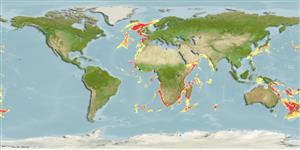Classification / Names
Common names from other countries
Main reference
Size / Weight / Age
Max length : 164 cm TL male/unsexed; (Ref. 58048)
Length at first maturity
Lm 124.5, range 110 - 158 cm
Environment
Marine; bathydemersal; depth range 145 - 2400 m (Ref. 6871)
Climate / Range
Deep-water, preferred 23°C (Ref. 107945); 69°N - 54°S, 92°W - 176°W
Distribution
North-western Atlantic, north-eastern and south-eastern Atlantic. Western and eastern Indian Ocean. South-western Pacific, north-western Pacific, and south-eastern Pacific.
Countries | FAO areas | Ecosystems | Occurrences | Introductions
Short description
Dorsal
spines
(total): 2;
Dorsal
soft rays
(total): 0;
Anal
spines: 0;
Anal
soft rays: 0. A large gulper shark with a short, broad snout, a long, low 1st dorsal fin, short pectoral rear tips, and large, rough, leaf-like denticles (Ref. 5578). Dark grey or chocolate brown in color (Ref. 5578).
IUCN Red List Status (Ref. 115185)
Threat to humans
Harmless
Human uses
Fisheries: minor commercial
More information
ReferencesAquacultureAquaculture profileStrainsGeneticsAllele frequenciesHeritabilityDiseasesProcessingMass conversion
Tools
Special reports
Download XML
Internet sources
Estimates of some properties based on models
Phylogenetic diversity index
PD50 = 0.5003 many relatives (e.g. carps) 0.5 - 2.0 few relatives (e.g. lungfishes)
Trophic Level
4.5 ±0.3 se; Based on diet studies.
Resilience
Low, minimum population doubling time 4.5 - 14 years (tmax=71; K=0.04-0.05; Fec=5-8)
Vulnerability
Very high vulnerability (86 of 100)
Price category
